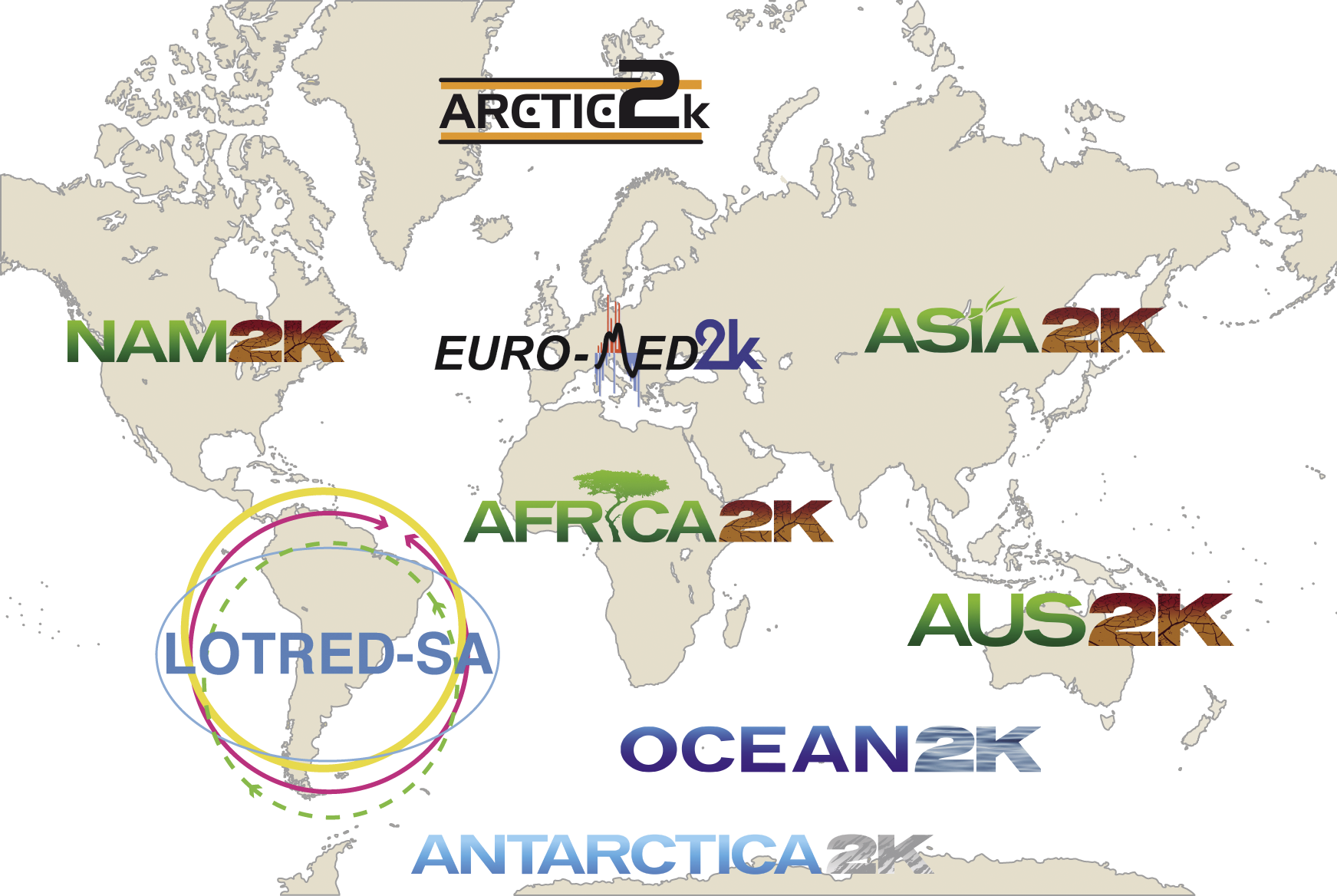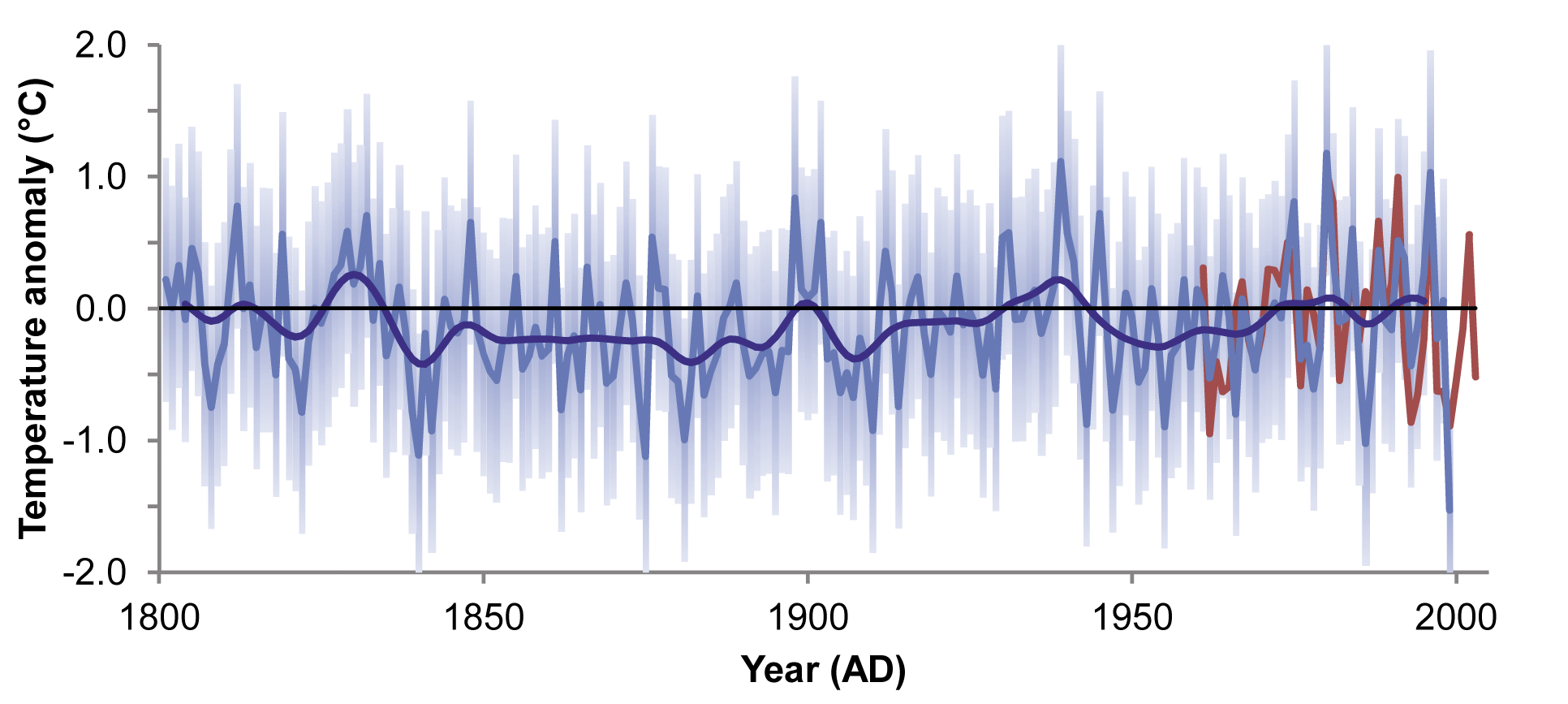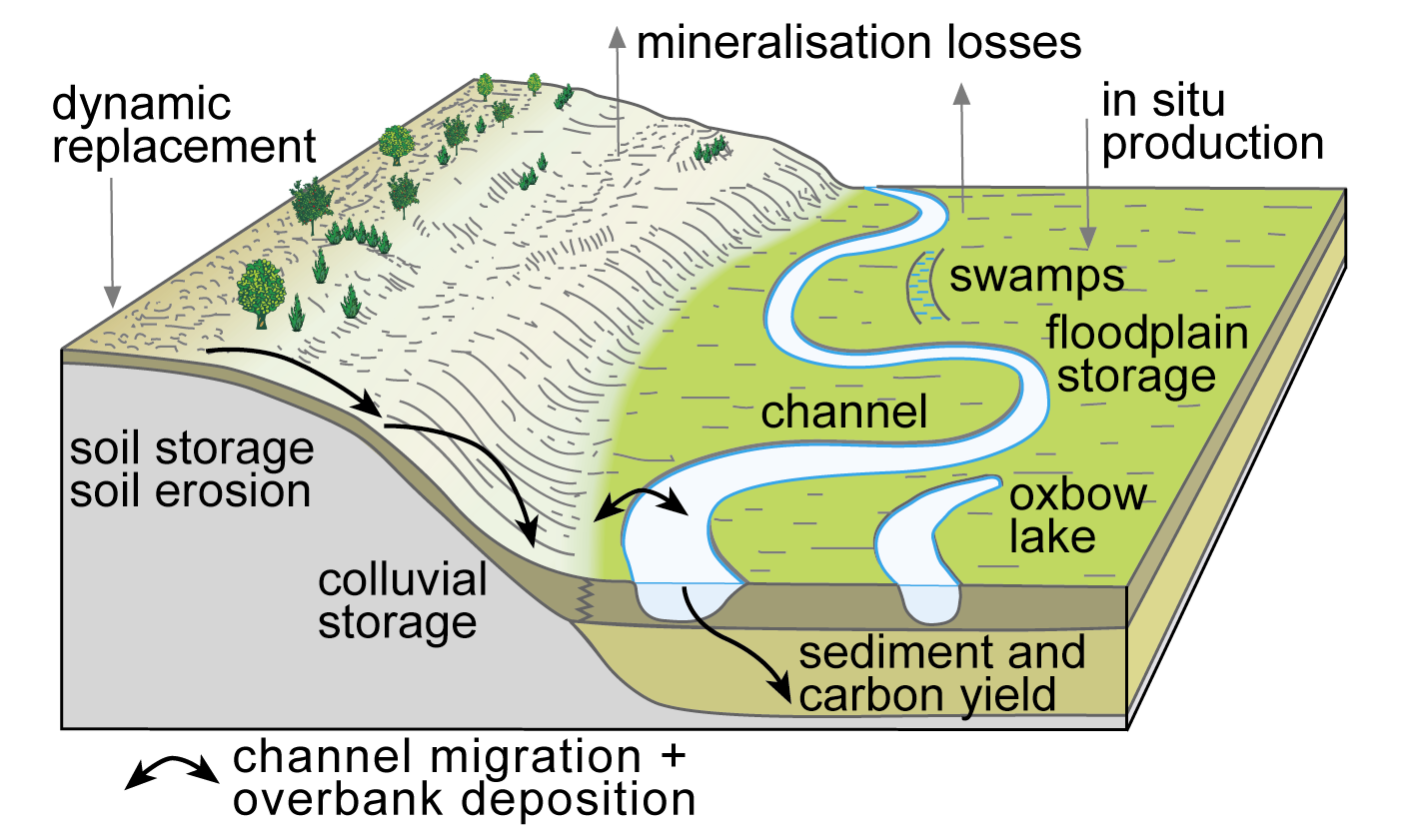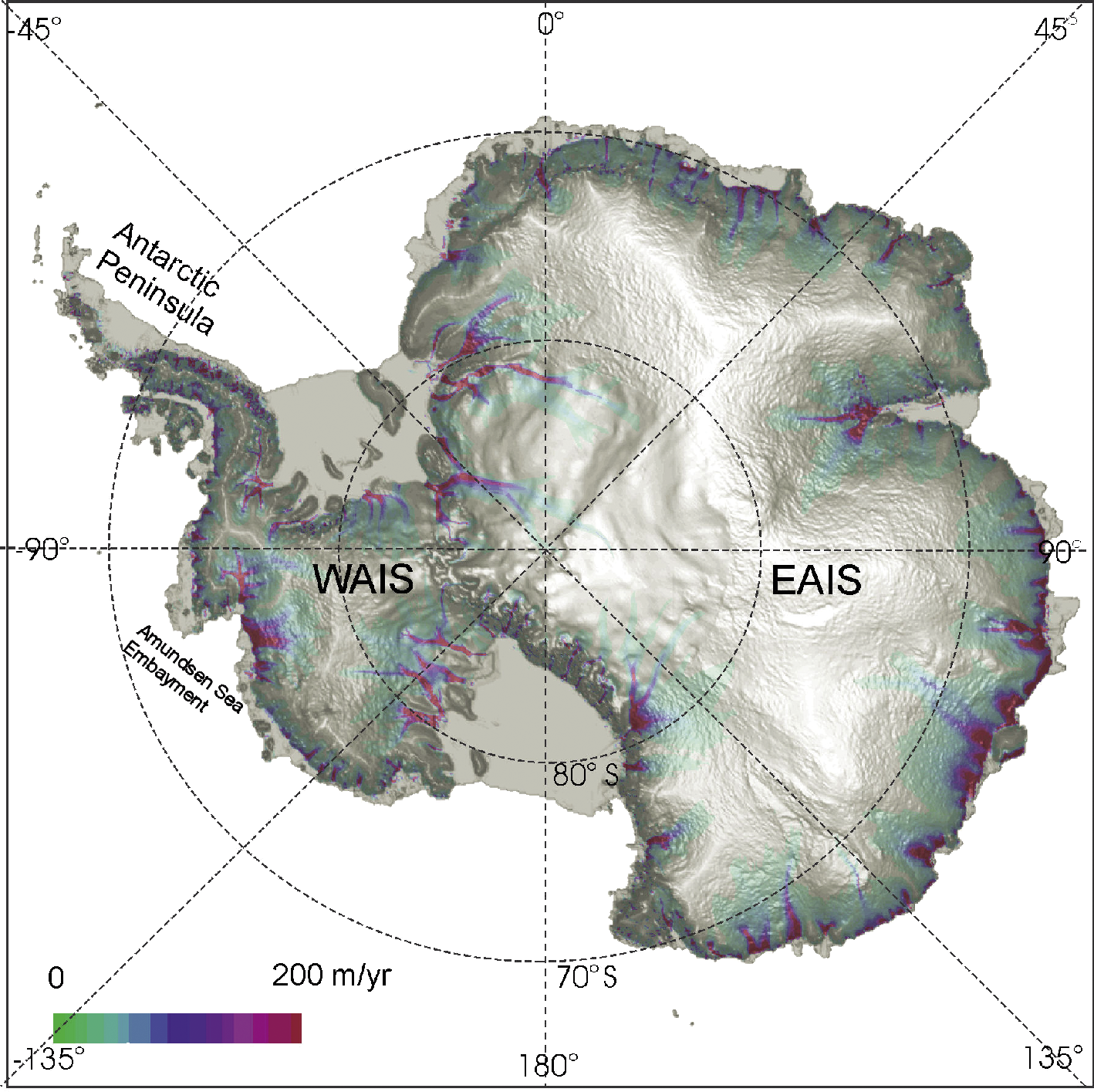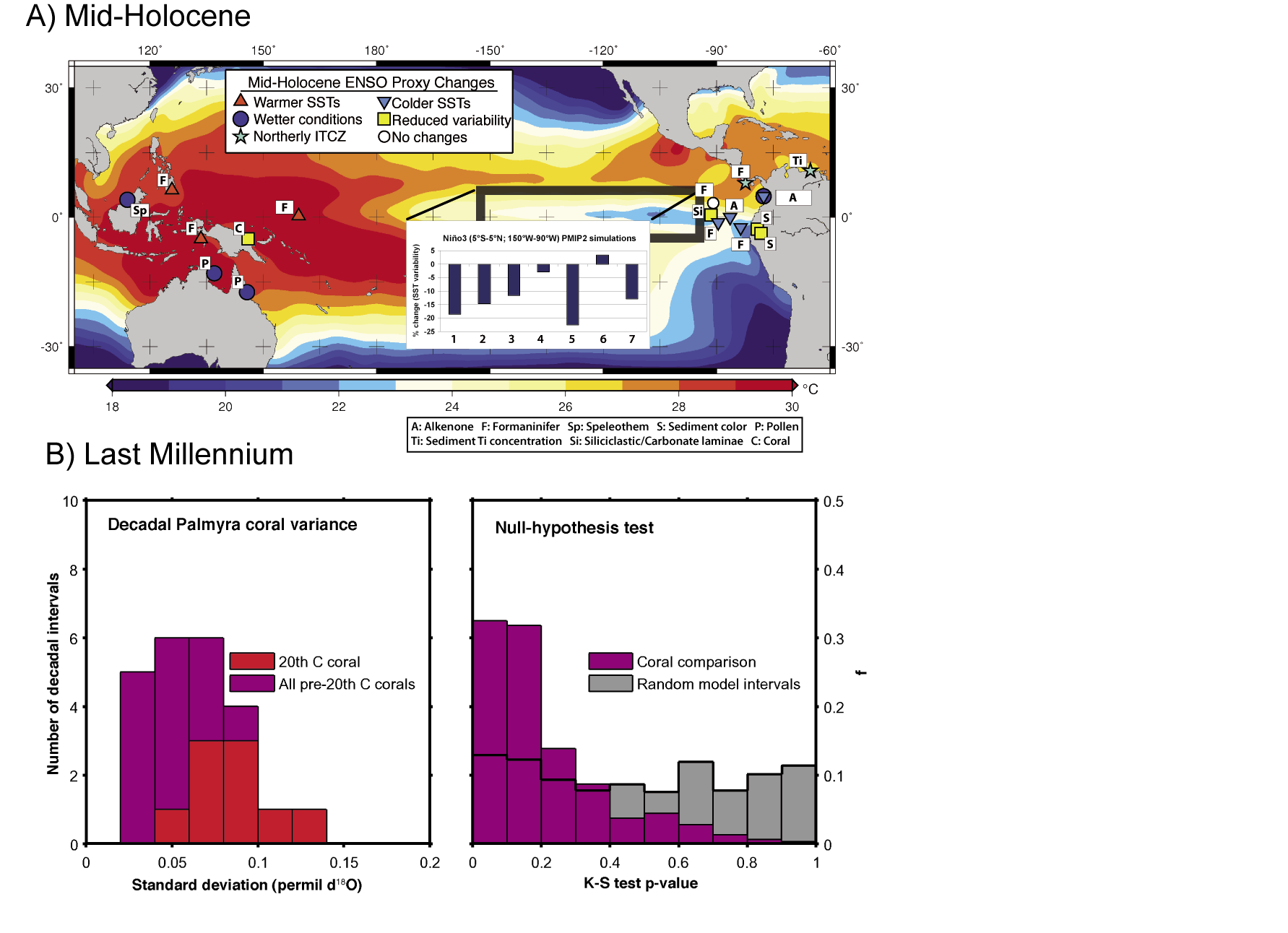- Home
- Taxonomy
- Term
- PAGES Magazine Articles
PAGES Magazine articles
Publications
PAGES Magazine articles
2012
PAGES news
 |
Lucien von Gunten1, H. Wanner2 and T. Kiefer1
1PAGES-International Project Office, Bern, Switzerland
2Oeschger Center for Climate Change Research, University of Bern, Switzerland; wanner oeschger.unibe.ch
oeschger.unibe.ch
Bern, Switzerland, 28 July 2011
The 2nd PAGES 2k Network Meeting took place in Bern one day after the XVIII INQUA Congress and was attended by 31 participants. The PAGES 2k coordinator Heinz Wanner gave an introduction on the scientific objectives, the concept, and the schedule of the PAGES 2k project. This was followed by presentations from all regional groups and from associated guests. The meeting wrapped up with strategic and scientific discussions.
All 2k regional groups (Fig. 1) agreed that the 2k Network should work towards a consortium paper for the IPCC AR5 manuscript submission deadline. It was agreed that drafts of the regional time series and accompanying explanatory text sections should be completed by January 2012 to provide enough time for the writing team to produce a meaningful synthesis. The two main aspects discussed in this regard were whether the firm timeline is realistic to produce reliable temperature reconstructions, and the difficulties of producing a temperature record for some regions, such as Africa, where natural archives appear to be sensitive mainly to precipitation. The plenary decided to attempt producing a first set of reconstructions to retain the current momentum of the 2k initiative and to focus on paleotemperatures because they were considered most useful for IPCC AR5. A stronger emphasis on precipitation and climate modes will be set for the final 2k synthesis.
Representatives of the eight regional 2k groups summarized recent activities, the results achieved since the first meeting in Corvallis in July 2009, and their possible contributions to the planned PAGES 2k consortium paper. Despite the difficulties encountered by several groups in identifying and processing a significant number of high-resolution proxies, the participants were impressed by the progress made within each group. Not surprisingly, the discussion was centered on how to include and compile the best proxy records in the available time, and how to organize the rapidly growing global data set.
Eugene Wahl from NOAA in Boulder, USA offered support to the 2k climate reconstruction process by way of hosting the 2k datasets. The NOAA Paleoclimatology branch will adapt a section of its Paleoclimate data bank to cater to the needs of the 2k groups. The plenary decided that each regional group would appoint a data manager in charge of the regional groups’ contributions to the 2k data collections and archiving.
Eugene Wahl also shed light on the revised concept and first available datasets of the PAGES-CLIVAR Paleoclimate Reconstruction (PR) Challenge. He (along with fellow PR Challenge co-leader Nicholas Graham) also invited all colleagues interested in paleoclimate reconstructions to participate in the PR Challenge. Incidentally, a report on the PR Challenge was published in the last issue of PAGES news (Graham and Wahl 2011).
Hugues Goosse (Louvain, Belgium) shared information on the existing/planned simulations being carried out by the PMIP3 community and by groups working with EMICs. He and Bette Otto-Bliesner (NCAR, Boulder) also expressed their interest in collaborating with the 2k-reconstruction community. The modeling community will be an integral part of the final 2k synthesis.
Realizing that the ocean regions are still insufficiently covered by the existing regional groups, the plenary suggested initiating a working group on high-resolution paleoceanographic reconstructions of the last 2k. A lead team has since formed around Mike Evans (Univ. Maryland, USA) and started the process (page 4). Finally, the plenary discussed the schedule and the goals for the final 2k-reconstruction synthesis. Collaboration with modeling activities will be intensified and a strong effort will be made to generate regional precipitation reconstructions and to analyze past circulation patterns and climate modes.
Figure 1: The nine regional groups of the PAGES 2k Network on 2000-year climate reconstructions.
references
Publications
PAGES Magazine articles
2012
PAGES news
Tas van Ommen1 and the Antarctica2k Steering Committee
1Australian Antarctic Division (AAD), Kingston, Australia; tas.van.ommen aad.gov.au
aad.gov.au
Bern, Switzerland, 19-20 July 2011
The first Workshop of the PAGES Antarctica2k meeting at the University of Bern was a successful start to the tasks of building a community for reconstructing Antarctic climate and the development of a plan to undertake such reconstructions within the PAGES 2k Network timeframe. The meeting resolved to make reconstructing Antarctic temperature a priority. At present, the best available reconstruction for the continent is that of Schneider et al. (2006) in Figure 1. Now, some five years later, additional records, new methodologies, and a longer meteorological calibration period are available. This last point is significant, as the very short extent of the high quality instrumental record in Antarctica (3-4 decades) makes even a 5-10 year extension in overlap with the proxy records valuable. The intention is to push the 200-year record back towards the 2000-year goal of the PAGES 2k Network.
This undertaking has some unique challenges attached to it. Beyond the short nature of the calibration period, the meteorological data are also spatially sparse and there is concern that the period of observations is coincident with the period of anthropogenic disturbance. On the proxy side, the high-resolution data network will presently be limited to ice core records. While ice cores are generally well suited to reconstruct climate, the Antarctica2k database will nevertheless be much less heterogeneous in proxy types than other geographic regions in the PAGES 2k Network. However, lower resolution proxy records will be incorporated for validation of decadal and centennial scale variability. In addition, the group has acknowledged the potential for high-resolution marine based records (Expedition 318 Scientists, 2010) that will be used at later stages of the project.
The work plan developed for the temperature reconstruction is organized around three groups: a data group (led by Mark Curran, AAD Australia) is assembling the input records and dealing with dating and quality control, a synthesis group (led by Tas van Ommen) will derive the actual high resolution reconstruction and a “non-ice” proxy group (led by Dominic Hodgson, BAS Cambridge) is working on the complementary lower resolution records.
At the meeting, good initial progress was made by the data group. Initial comparison of volcanic records from Law Dome (Eastern Antarctica), the West Antarctic Ice Sheet and Greenland confirmed the potential of a common volcanic-tie chronology to underpin the 2000-year record. Law Dome and Greenland volcanic marker ages agree within 4 years at 168 AD. The data group will assemble the ice core records (water isotope and associated volcanic data) with chronological and quality control to ensure consistent dating. This phase is expected to be completed by November 2011. The synthesis will then take place and an initial reconstruction product is expected for early 2012. Discussion at the workshop around the analysis issues acknowledged that the unique challenges noted above might lead to problems with some of the statistical reconstruction methods. Therefore the group will investigate a range of reconstruction approaches.
Later in the PAGES 2k Network timeframe, the Antarctica2k group will investigate reconstructions for other variables including precipitation.
The steering committee for the Working Group comprises Tas van Ommen (leader), Hubertus Fischer, Dominic Hodgson, Mark Curran, Valérie Masson-Delmotte, Bo Vinther and Liz Thomas. We welcome participation from the Antarctic paleoclimate community.
Figure 1: Antarctic temperature reconstruction from AD 1800-2000 based on five ice core sites (adapted from Schneider et al. 2006). Blue curves are the annual reconstruction and a decadal smooth (Gaussian with σ=3 years). Error shading shows 95% confidence interval. Red curve is calibration temperature target. The zero reference is the 1961-1990 climatological mean.
references
Expedition 318 Scientists (2010) IODP Preliminary Report 318, doi: 10.2204/iodp.pr.318.2010
Schneider et al. (2006) Geophysical Research Letters 33, doi: 10.1029/2006GL027057
Publications
PAGES Magazine articles
2012
PAGES news
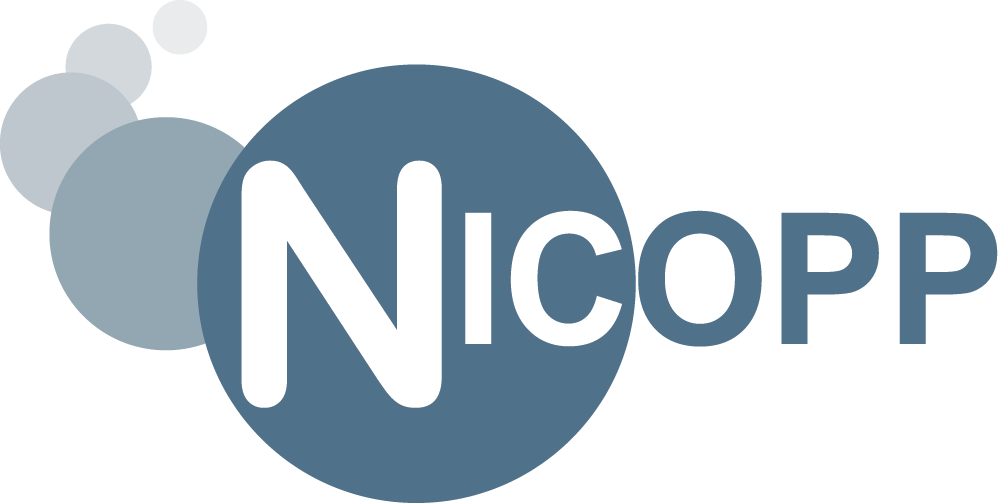 |
Patrick A. Rafter1, S.L. Jaccard2, E.D. Galbraith3, T. Kiefer4 and M. Kienast5
1Department of Geosciences, Princeton University, Princeton, USA; prafter princeton.edu
princeton.edu
2Climate Geology, ETH Zurich, Switzerland
3Earth & Planetary Sciences, McGill University, Montreal, Canada
4PAGES International Project Office, Bern, Switzerland
5Department of Oceanography, Dalhousie University, Halifax, Canada
2nd NICOPP meeting, Halifax, Canada, 8-10 July 2011
Discussions among the 21 scientists attending the NICOPP 2011 meeting confirm that this is an exciting time to be studying nitrogen (N) cycling in the past and present oceans. For example, measurements of the N isotopic composition (δ15N) of marine nitrate and nitrite (the most widely available forms of marine N) are now relatively commonplace and sedimentary reconstructions of past N cycling processes are becoming increasingly sophisticated through the use of microfossil-bound and compound-specific δ15N. These new techniques allow us to identify isotopic distinctions between sedimentary and species size fractions, which promise to provide an even more detailed look at past N cycling and related ocean conditions. Furthermore, the laboratory-based data provide crucial benchmarks for computer-based simulations of the marine N cycle. All of these approaches provide insight to ocean productivity and the biogeochemical processes associated with both N and carbon cycling, such as nitrate assimilation by phytoplankton and denitrification in oxygen-deficient zones.
Past N cycling was a dominant topic for two themes of the meeting: the global sediment δ15N database (proposed at NICOPP 2010, Galbraith et al. 2010) and the impact of diagenesis on whole sediment δ15N (total combustible sedimentary N; also known as “bulk”).
Global sediment δ15N database
To date, 138 records of whole sediment δ15N variability covering the last ca. 2.5 Ma have been compiled into a database, which will be described in a publication and made available to the community shortly (Fig. 1). The compilation is promising but also highlights the need for enhanced geographical coverage in particular in the largely neglected subtropical gyres and most of the Southern Hemisphere. This sediment δ15N database will be a powerful tool for reconciling marine N cycling with past changes in the mean climate state.
The influence of diagenesis
Even with significant developments in the use of alternate sedimentological δ15N records such as microfossil-bound and compound-specific δ15N, much of our knowledge of past N cycling processes will continue to rely on whole sediment δ15N, given that it can be measured in any sediment at relatively low cost. However, at some sites, coretop whole sediment δ15N is elevated relative to the expected export from the modern surface ocean. The underlying cause of the δ15N enrichment is assumed to be the preferential loss of 14N during the remineralization of freshly deposited organic matter or “diagenetic fractionation”.
This issue was a major concern of NICOPP 2011 with several presentations dedicated to using the global sediment δ15N database and whole sediment / microfossil δ15N measurements to discuss why and where diagenetic fractionation is important. Among these discussions, several investigators independently converged on the finding that coretop whole sediment δ15N in the deep-sea, which ranges from 1-17‰, is on average 2 ± 2‰ higher than values from sediment trap time series at the same sites. However, where coretop sediments were measured for both whole sediment and microfossil-bound δ15N (assumed to be resistant to diagenetic alteration) they generally agreed. These findings suggest that coincident measurements of whole sediment and microfossil-bound / compound-specific δ15N will help answer why deep-sea coretop sediment δ15N is elevated, by illuminating the molecular transformation of sedimentary organic matter. Furthermore, where the fidelity of whole sediment δ15N is assured (i.e. in the case of little terrigenous input and minimal diagenetic fractionation) differences with microfossil-bound δ15N could provide new insight to surface ocean N cycling processes.
Interlaboratory calibration
On a different note, a laboratory intercalibration was proposed to optimize comparison between whole sediment δ15N records. Laboratories interested in joining the effort should please contact Mark Altabet (maltabet umassd.edu).
umassd.edu).
Figure 1: Global distribution of available sedimentary δ15N records, together with their respective temporal coverage and resolution. Cores that do not cover the last glacial cycle are marked by an open symbol.
references
Galbraith E, Kienast M and Kiefer T (2010) PAGES news 18(2): 92-93
Publications
PAGES Magazine articles
2012
PAGES news
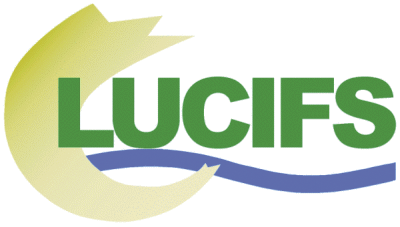 |
Thomas Hoffmann1, G. Erkens2, G. Verstraeten3, H. Middelkoop2 and A. Lang4
1Department of Geography, University of Bonn, Germany; thomas.hoffmann uni-bonn.de
uni-bonn.de
2Department of Physical Geography, Utrecht University, The Netherlands
3Division of Geography, University Leuven, Belgium
4School of Environmental Science, University of Liverpool, UK
LUCIFS Workshop, Bern, Switzerland, 28-30 July 2011
Sediment-burden carbon fluxes represent a considerable yet insufficiently understood component of the global carbon (C) cycle. The contribution of soil erosion and sediment transport on hillslopes and in channels to greenhouse gas emission and/or long-term C storage remains largely unknown. The major aim of the workshop was to bring together leading and early-career scientists focusing on C and sediment fluxes from different viewpoints (e.g. soils, hillslopes, fluvial and limnic systems). Perspectives for unravelling long-term sediment-burden C fluxes and the prospects of establishing the relationships between C and sediment fluxes were discussed. In addition, concepts, methods and regions that are best suited for establishing Holocene sediment-carbon fluxes were identified. The workshop was organized by the PAGES working group LUCIFS (Land Use and Climate Impacts on Fluvial Systems) under the Focus 4 Themes “Sediment” and “Carbon”. A total of 19 researchers from different disciplines (ecology, geology, geomorphology and limnology) and countries (Belgium, Ethiopia, Germany, Japan, Switzerland, The Netherlands, UK and USA) contributed to the workshop.
Discussions on the first day focused on the contribution and importance of single system components along the sediment/carbon flow path (e.g. hillslopes, floodplains and lakes) and their interconnections. Kristof van Oost (Louvain, Belgium), Rolf Aalto (Exeter, UK), and John Boyle (Liverpool, UK) gave keynotes speeches on organic C storage and erosion on hillslopes, floodplains and lakes. The second day’s session focused on the wider implications of environmental changes (including climate change and human impacts) on sediment-burden C fluxes. Simon Mudd (Edinburgh, UK) and Jed Kaplan (Lausanne, Switzerland) presented ideas on quantifying long-term soil production and biogeochemistry to use as baseline information for modern soil processes. They also discussed Holocene C flux and land use changes. Jane Willenbring (Pennsylvania, USA) gave a presentation on quantifying long-term C loading from anthropogenic erosion. On the third day, Fritz Schlunegger and Fabian Van den Berg (Bern, Switzerland) led a fieldtrip to showcase subglacial erosion, the formation of inner valley gorges and knickpoint retreat in glacial hanging valleys.
All presentations highlighted the current overly simplistic consideration of hillslopes and channels in models of the global C cycle; hillslopes are often represented as simple engines that release C through soil formation and subsequent erosion, and fluvial channels are often viewed as pipes that passively transport carbon from the hillslopes to the oceans. During the workshop it became clear that sediment-burden C fluxes are altered by various processes at different spatial and temporal scales. Sediments eroded at hillslopes may be stored several times under different environmental conditions along the flow path to the oceans. During storage, organic C can either decompose or build up depending on the specific environmental conditions. Four key mechanisms determine the coupled sediment/carbon flux: i) dynamic replacement of eroded C due to soil formation, ii) increased mineralization of C due to aggregate breakdown during transport, iii) protection of eroded organic material through burial and iv) organic matter complexation (Fig. 1). On short timescales (ca. 50 years) soil erosion seems to have only limited effects on atmospheric CO2-concentrations, while on longer timescales (centuries to millennia) the C protection through burial dominates. This shows the clear need to define the relative importance of each key mechanism for specific timescales and environmental conditions. Furthermore, the discussion groups identified major gaps in understanding of feedback mechanisms between soil erosion and C fluxes, such as interdependence of soil productivity and ecological diversity. Such feedbacks may irreversibly alter the C cycling and might even be more important than direct fluxes. The participants of the workshop stressed the need for comparative studies on direct and indirect effects of soil erosion on the C cycle. These are needed to evaluate the effects of human-induced soil erosion in areas with different geology, climate and land use history.
Figure 1: Sediment-burden carbon fluxes on hillslopes and in floodplains; representing key mechanisms as mentioned in the text.
Publications
PAGES Magazine articles
2012
PAGES news
Mark Siddall1, Peter Huybers2 and Jerry X. Mitrovica2
1Department of Earth Sciences, University of Bristol, UK; mark.siddall bristol.ac.uk
bristol.ac.uk
2Department of Earth and Planetary Sciences, Harvard University, Cambridge, USA
PALSEA PAGES/IMAGES workshop, Harvard, USA, 25-27 August 2011
This 4th PALSEA workshop was hosted and co-sponsored by the Harvard Centre for the Environment and was an opportunity for a wide-ranging discussion amongst scientists active in the collection and analysis of relevant sea level and ice sheet data sets, and the modeling and development of theory for representing changes in the oceans and cryosphere.
Anders Carlson presented results on geochemical fingerprinting of ocean sediment to differentiate areas of Greenland where the ice sheet had retreated during the Last Interglacial (LIG) (Colville et al. 2011). Bob Kopp presented efforts to extend his Bayesian analysis of the Glacial Isostatic Adjustment (GIA) response during the LIG using relative sea level (RSL) data to attribute sea-level rise (Kopp et al. 2009). Maureen Raymo presented exploratory work looking at Mid-Pliocene Warm Period (MPWP) RSL indicators alongside GIA modeling from Jerry Mitrovica (Raymo et al. 2011). Early modeling results indicate that the GIA response globally varies by the order of ten meters and can plausibly explain much of the divergence of the RSL data for this period.
Andrea Dutton and Bill Thompson presented two methodologies for interpreting fossil coral indicators of RSL for the LIG. Their results show differences but also similarities, most particularly that there is at least one period during which sea level appears to fall and then rise again by up to several meters (for full discussion see PALSEA website: http://eis.bris.ac.uk/~glyms/working_group.html).
Christian Schoof presented his work on grounding line stability (e.g. Schoof 2007), which has been incorporated into ice sheet models. Richard Hindmarsh talked about validation of the marine ice-sheet instability theory. A fresh look at the theoretical underpinnings by Schoof (2007) emphasizes the importance of the boundary layer near the grounding line. He presented evidence from an analogous flow situation, the ice shelf calving front, to show that the boundary layer theory operates as expected. The Weertman instability hypothesis (1974) suggests that there is a positive feedback causing the collapse of a marine ice sheet sitting on a bed that slopes down inlands. Natalya Gomez coupled a 1D dynamic ice-sheet model to a sea-level model with viscoelastically deforming Earth model and found that the sea-level fall predicted during periods of ice-sheet reduction could stabilize ice sheets, reducing the effectiveness of the Weertman instability mechanism and slowing down ice sheet retreat (Gomez et al., in press).
David Pollard discussed the complications for modeling the Antarctic ice sheet posed by sequence stratigraphy data of the ice sheet. In particular, records from the New Jersey margin (Miller et al. 2005) show large fluctuations in sea level, which are not easily captured by the model. Ayako Abe-Ouchi presented challenges in coupled ice sheet-climate modeling, especially in simulating rapid changes (Abe-Ouchi et al. 2007). For example, the model does not currently simulate the precise timing and character of the termination of the last glacial period and the glacial inception at the conclusion of the LIG.
Glenn Milne presented results of GIA modeling of RSL data from the Greenland coast (Long et al. 2010). Reconciling these data with existing GIA models of the Laurentide ice sheet collapse is an ongoing challenge.
Shawn Marshall led a discussion on observed processes that may drive rapid ice sheet responses in the present day. Discussion centered on the effect of melt ponds on the albedo of the ice sheets and in particular the multi-year accumulation of heat in the ice sheet. This effect increases the scope for the formation of melt channels to move fluid to the base of the ice sheet, where it reduces friction with the bed. Ben Horton presented a new RSL record from the east cost of the USA covering the last two millennia (Kemp et al., in press) demonstrating that modern sea-level rise is anomalous compared to the pre-industrial period. Finally, Jonathan Bamber presented preliminary results of an elicitation exercise, which asked experts on ice sheet dynamics to assess the likelihood of several scenarios regarding ice sheet and ice shelf stability in the next centuries. For example, the question was posed “how much will the WAIS contribute to sea-level rise in the twenty first century”. There was broad agreement between experts, though the opinion of some experts acted as clear outliers.
Figure 1: Surface topography derived from satellite radar altimetry and steady-state ice flow rates for the Antarctic ice sheet for the present-day (Bamber et al. 2007). Reprinted with permission from Elsevier.
selected references
Full reference list online under: http://pastglobalchanges.org/products/newsletters/ref2012_1.pdf
Colville EJ et al. (2011) Science 333: 620-623
Gomez N et al. (in press) Journal of Geophysical Research
Kemp AC et al. (in press) PNAS, doi: 10.1073/pnas.1015619108
Long AJ et al. (2010) Quaternary Science Reviews 29(3-4): 367-383
Publications
PAGES Magazine articles
2012
PAGES news
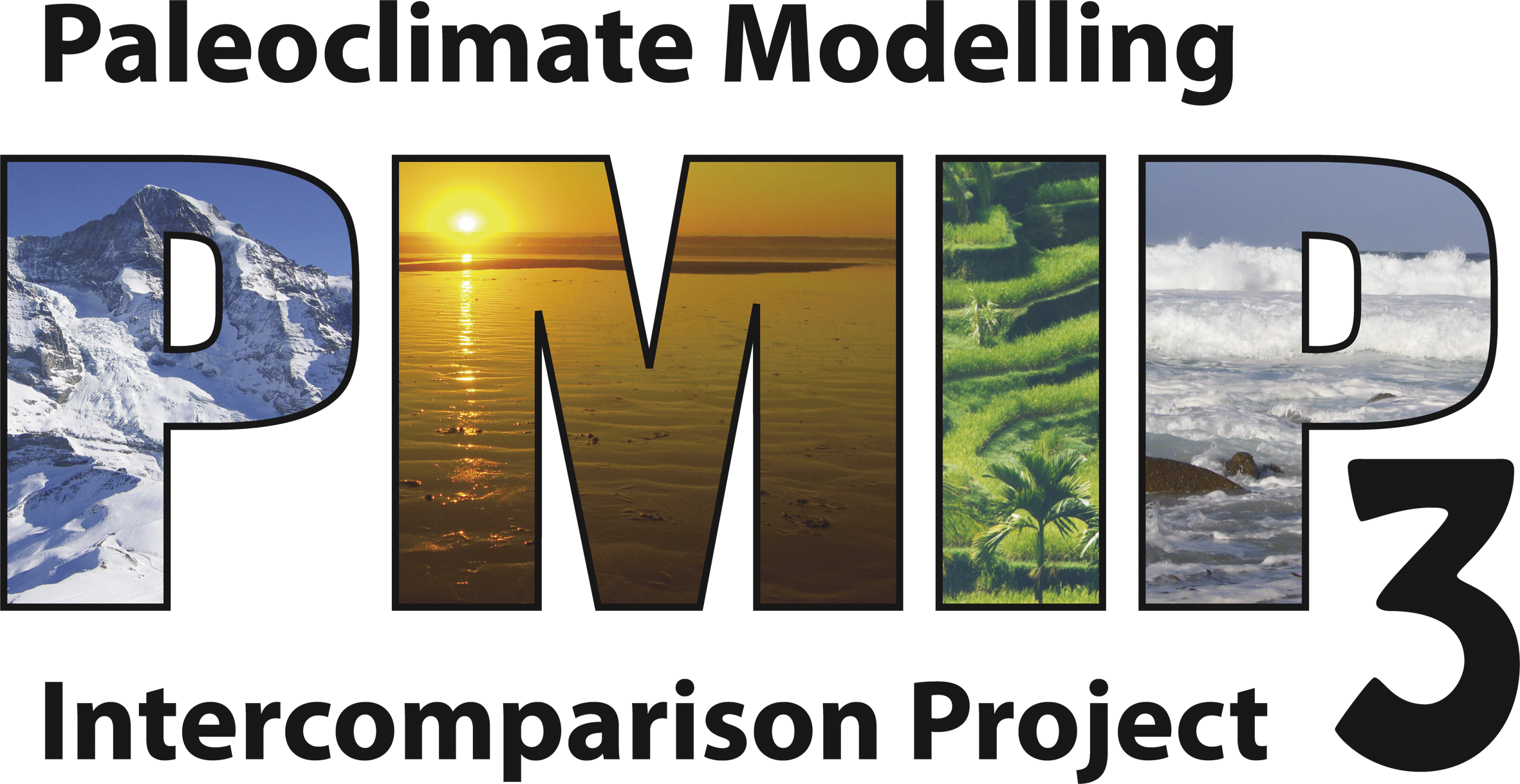 |
Pascale Braconnot1, S.P. Harrison2, S. Tudhope3 and C. Michaut4
1Laboratoire des Sciences du Climat et de l’environnement, CEA-CNRS, Gif-Sur-Yvette, France; pascale.braconnot lsce.ipsl.fr
lsce.ipsl.fr
2School of Biological Sciences, Macquarie University, North Ryde, Australia
3Department of Geology and Geophysics, University of Edinburgh, UK
4Institut Pierre Simon Laplace, UVSQ, France
PMIP3 Workshop, Villefranche-sur-Mer, France, 21-23 September 2011
Twenty scientists assembled at Villefranche-sur-Mer, southern France to foster analyses of past climate variability from model and observations. They included scientists representing a diversity of high-resolution climate archives and climate modelers focusing on the analysis of short-term variability in paleoclimate simulations. The Observatory of Haute Provence served as the workshop venue thanks to support from the staff of that institute. The charming location, perfect Mediterranean weather, excellent food, and enthusiasm of the participants all contributed to make this a stimulating and productive workshop. WCRP, PAGES, INQUA/PALCOMM and IPSL supported this meeting.
The El-Niño/Southern Oscillation (ENSO) is the major mode of climate variability in tropical regions. ENSO monitoring, understanding, and prediction have received a lot of attention in recent decades because it strongly affects the economy of tropical regions and beyond (McPhaden et al. 2006). However, there remain major uncertainties regarding the fluctuations and future evolution of ENSO. The increasing number of records from natural archives (corals, mollusk shells, varved sediments, speleothems, tree rings, etc.) with annual or sub-annual resolution now available finally enables us to draw a consistent picture of past changes in tropical climate variability. On the modeling side, the Last Millennium, the Mid-Holocene (6 ka) and the Last Glacial Maximum (21 ka) are the three main foci of the CMIP5/PMIP3 project for multi-model ensemble paleoclimate simulations (Taylor et al. 2011). These paleo-simulations are run with the same model version that each modeling group is using for future climate projections in CMIP5. This allows us to test how the simulated variability is affected by changes in the climate background state. However, to evaluate how well these models reproduce observed changes in ENSO variability, it is first necessary to produce a pan-tropical synthesis of past changes in ENSO variability that includes all the possible types of record and a critical evaluation of these records. Furthermore, specific criteria and new methodologies need to be developed to facilitate data-data and data-model comparisons.
In this context, the objectives of this meeting were to determine the best way to produce a “synthetic” product on short-term (interannual to decadal) climate variability in tropical regions and to design analyses of the CMIP5/PMIP3 simulations. On the first day, participants presented the modeling tools, summarized available paleodata and discussed the difficulties inherent in the analysis and interpretation of these records including how to overcome them. Thereafter, two working groups (focusing on the Last Millennium and the mid-Holocene) discussed interpretative issues and determined the best way to include information from different archives within a common framework. The working groups also discussed the analyses of model experiments and observations to characterize variability for each time period. Several plenary sessions allowed discussion of cross-cutting methodological issues.
A plan for a multi-authored publication in a high-profile journal of the current state-of-knowledge about changes in tropical variability based on data analysis, model experiments and data-model comparisons emerged from the working group efforts. The meeting participants produced a draft outline for this paper, including key results and design of the figures.
These three intensive days of meeting are only the beginning. Work will continue in the coming months with the aim of completing the synthesis paper early next year. In addition, several participants agreed to contribute to a PAGES (or PAGES/CLIVAR Intersection) newsletter focused on past ENSO.
references
Full reference list online under: http://pastglobalchanges.org/products/newsletters/ref2012_1.pdf
Braconnot P, Luan Y, Brewer S and Zheng W (2011) Climate Dynamics, doi: 10.1007/s00382-011-1029-x
Cobb KM, Charles CD, Cheng H and Edwards RL (2003) Nature 424: 271-276
Publications
PAGES Magazine articles
2012
PAGES news
New Working Groups
Three new PAGES Working Groups have been established since the last newsletter to help strengthen PAGES science.
The Sea Ice Proxies (SIP) was formed to critically assess and compare the different proxies for sea ice, in order to make recommendations about the reliability and applicability of each in the Arctic and the Antarctic setting. An extended objective will be to facilitate the production of new synthesis estimates of past sea ice extent based on the assessed proxies.
The Solar Forcing Working Group was created with the aim of bringing together scientists from the solar physics, climate modeling, and palaeoclimate reconstruction communities and contribute to a better mutual understanding and closer collaboration over open questions relating to solar-terrestrial interactions.
A new Ocean2k Working Group was created to complete the PAGES 2k Network that looks into the climate of the past two millennia. Ocean2k is also endorsed by CLIVAR and attempts to reconstruct and analyze the sea surface conditions and marine climate of the last two millennia. Paleoceanographic evidence is compiled from high-resolution archives, mostly sedimentary cores and corals (see page 4).
Staff updates
Michelle Kaufmann has relinquished her position as PAGES Finance and Office Manager. We wish her all the best and are grateful for her six years of dedicated service. Michelle has been replaced by Sonja Nyfeler and Francesca Baumgartner, who are sharing the duties between them. Sonja will stay on until her maternity leave in June after which Francesca will assume full charge of administrating PAGES finances.
New SSC members
Bette Otto-Bliesner, former PAGES co-chair, rotated off the Scientific Steering Committee (SSC) along with SSC members Cathy Whitlock and Zhongli Ding. Sadly, Mohammed Umer who was also scheduled to rotate off, passed away in November (page 3). PAGES is grateful for their commitment and stewardship all these years.
Alan Mix has replaced Bette as PAGES co-chair.
Four new members have been nominated to serve on the PAGES SSC from January 2012:
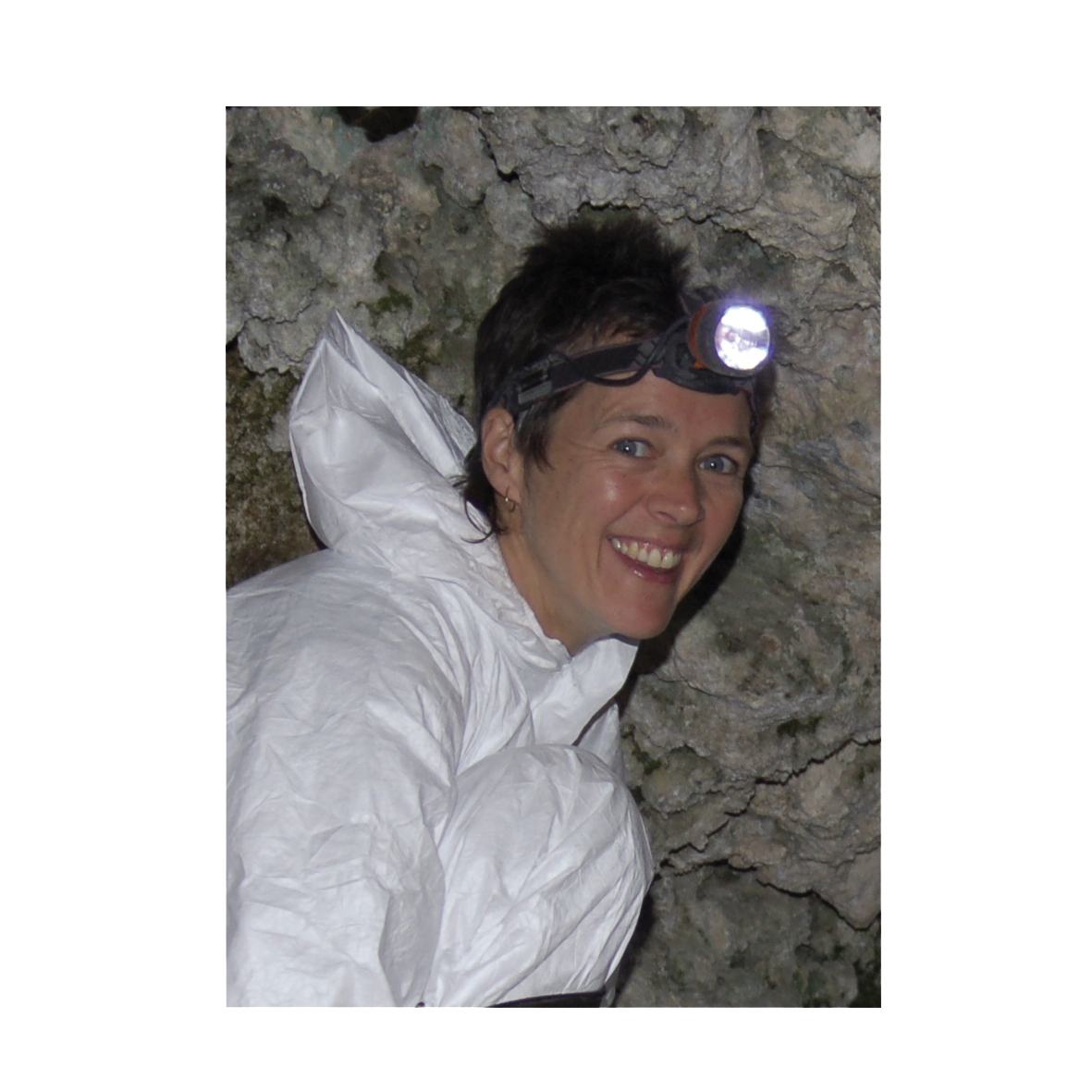 |
Janet Wilmshurst is a paleoecologist at Landcare research based in Lincoln, New Zealand. Her work focuses on applying paleoecological perspectives to current ecological issues. She is currently working on the effects of natural disturbance (volcanism, fire, storms, and earthquakes) on New Zealand’s Holocene vegetation; the impacts of initial human settlement on pristine island ecosystems in South and East Polynesia; past diets of extinct avian herbivores; and the effects of introduced vertebrates on vegetation.
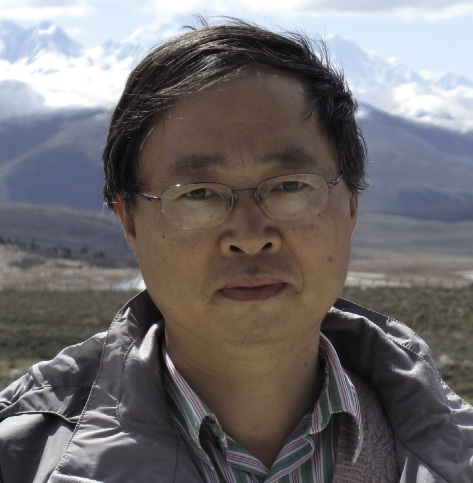 |
Liping Zhou is the Cheung Kong Professor of Physical Geography at Peking University in Beijing, China. He has mainly worked on chronology of geological and archaeological records in arid and semi-arid regions in northern mid-latitudes. His current research involves extensive use of 14C and 10Be in the study of biogeochemical dynamics on land and in the ocean. He is vice president of the Stratigraphy and Chronology Commission, INQUA.
 |
Sheri Fritz is the George Holmes University Professor at the University of Nebraska – Lincoln, USA with appointments in both the Department of Earth and Atmospheric Sciences and the School of Biological Sciences. Her research uses lacustrine stratigraphic sequences to reconstruct past patterns of climate variation and of biotic and ecosystem evolution.
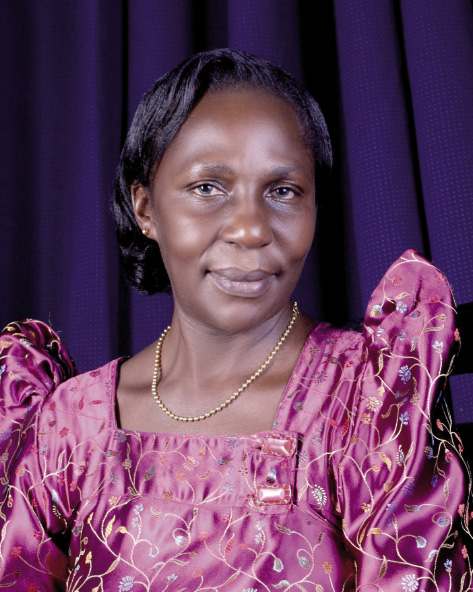 |
Immaculate Ssemmanda is a palynologist and lecturer in the Department of Geology at Makerere Univeristy in Kampala, Uganda and has been active in paleoclimate research in East Africa since the early 1990s. She is currently working on reconstructing past vegetation change in western Uganda as a part of a larger project on climatic and anthropogenic impacts on African ecosystems.
SSC nominations
PAGES invites nominations of scientists to serve on its SSC, which is responsible for overseeing PAGES activities. Scientists who serve on the SSC normally do so for a period of 3 years, with the potential for renewal for an additional term.
Up to 3 new members are sought to join in 2013. Deadline for sending in nominations is 5 March 2012. Please refer to the PAGES website for nomination guidelines (My PAGES > Get Involved).
OSM and YSM in 2013
The 4th PAGES Open Science Meeting (OSM) & 2nd Young Scientists Meeting (YSM) will be held on 13-16 Feb 2013 and 11-12 Feb 2013 respectively in Goa, India. With less than a year left, the local hosts and PAGES are working enthusiastically to ensure the meetings will be memorable and showcase the best in paleoscience. The theme for the OSM and YSM is The Past: A Compass for Future Earth. It was chosen to reflect the role of paleoscience in the recent shift towards sustainability and finding solutions.
Next newsletter issue
The forthcoming issue of PAGES news will showcase the latest work of PAGES-relevant science in Japan. Subsequently PAGES is preparing a newsletter with a special section on ENSO. Most of the articles are already in preparation but particularly fitting articles with new perspectives on ENSO are still welcome. Please send your contribution ideas to Pascal Braconnot (pascale.braconnot lsce.ipsl.fr) before 31 May 2012.
lsce.ipsl.fr) before 31 May 2012.
You are also invited to submit at any time Science Highlights, Program News and Workshop Reports for the Open Section of PAGES news. Guidelines for authors can be found on the PAGES website (My PAGES > Newsletter).
Meeting support
The deadline for applying for PAGES meeting support is 5 March 2012. The subsequent deadline will be 30 September 2012.
PAGES offers meeting support for three categories of workshops that are relevant to PAGES Foci and Cross Cutting Themes: PAGES Working Group Meetings, Educational Meetings, and Open Call Meetings.
Application guidelines and online form can be found on the PAGES website (My PAGES > Meeting Support).
Publications
PAGES Magazine articles
2012
PAGES news
Valerie Trouet1, D. Stahle2 and H. Diaz3
1Laboratory for Tree-Ring Research, University of Arizona, Tucson, USA; trouet ltrr.arizona.edu
ltrr.arizona.edu
2Department of Geosciences, University of Arkansas, Fayetteville, USA
3Cooperative Institute for Research in Environmental Sciences, University of Colorado, Boulder, USA
NAM2k Workshop, Tucson, USA, 26‐28 October 2011
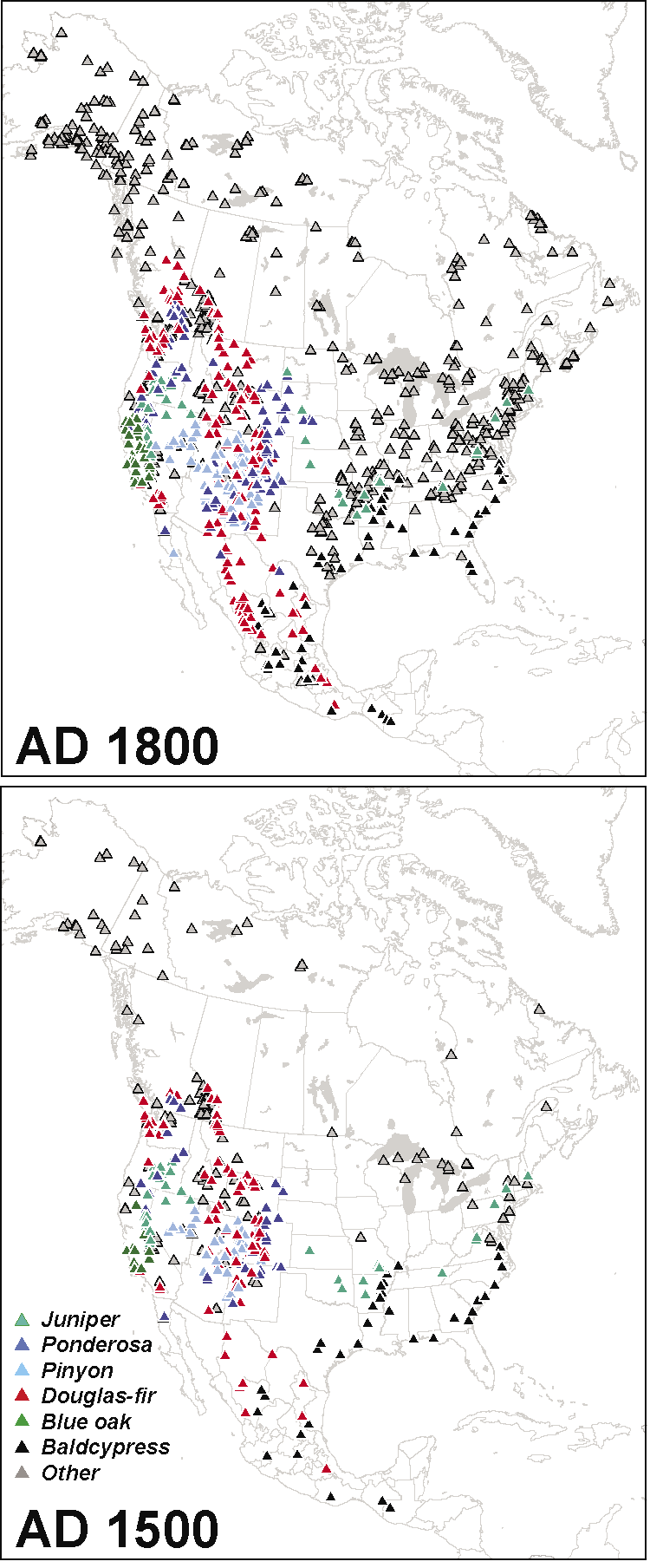 |
|
Figure 1: Species-specific tree-ring chronologies available for the North American continent that extend back to AD 1800 and AD 1500. |
During the first meeting of the PAGES North American 2k Working Group (NAM2k) in Flagstaff, USA, in May 2011, a task group was assigned to collaborate on the assimilation of available data sources and exploration of spatiotemporal analysis tools. Considering the numerical dominance of tree‐ring data within the climate proxy data pool for North America, this task group focuses in first instance on compiling and analyzing tree‐ring data, with the goal of producing a high-resolution reconstruction of key climate variables for North America (including Canada, USA, and Mexico). The necessary steps towards achieving this goal were discussed by 12 paleoclimatologists from the USA and Canada in a workshop held at the University of Arizona in Tucson. The workshop was supported by the University’s Institute of the Environment and by PAGES.
The participants first discussed available tree-ring data and their characteristics, including time-series length, seasonality, climate parameter calibration, and geographic representation (Fig. 1). The North American Drought Atlas (NADA, Cook et al. 2004) was generally accepted as a spatially explicit, high‐resolution drought reconstruction for North America that can likely not be improved upon without extensive new data collection. The working group will therefore aim to complement the NADA with a continental‐scale temperature reconstruction equivalent.
Two general approaches to the development of such a gridded temperature reconstruction were suggested: (1) compilation of all available tree‐ring data, regardless of the strength of their temperature‐sensitivity and extraction of the best possible temperature signal out of this extended data set or (2) a priori selection of best qualified tree-ring data and reconstruction development based on this limited data-set. The workshop participants decided to adopt the second approach and defined a set of selection criteria including a minimum time‐span covered by the tree‐ring series (AD 1650-1990) and strength (r>0.316), sign (positive), and seasonality (summer) of the temperature signal in the tree-ring series. Tree‐ring chronologies from the International Tree‐Ring Database (ITRDB) will be screened according to these criteria and complemented by chronologies from individual researchers, which have not yet been contributed to the ITRDB. The raw ring-width data contributing to the selected chronologies will be detrended using a signal-free approach before implementation in the reconstruction algorithm.
The task group aims to first apply a nested empirical orthogonal functions (EOF) based methodology. In a first step, only the tree-ring data covering the time-period AD 1200-1990 will be included. The next phase will include all previously selected tree-ring data. In addition to this EOF-based approach for spatial reconstruction, a Bayesian Hierarchical Model (BHM) will be used to extract climate information from the tree-ring time-series. Both methodologies will initially be run on annual time-scales, but also decadal-scale reconstructions will be developed that allow for inclusion of other, decadal-resolution proxies, including pollen data. For this purpose, the NAM2K working group will collaborate closely with the Arctic working group and a joint workshop will be organized.
reference
Publications
PAGES Magazine articles
2012
PAGES news
Henry F. Lamb
Institute of Geography and Earth Sciences, Aberystwyth University, Aberystwyth, UK; hfl aber.ac.uk
aber.ac.uk
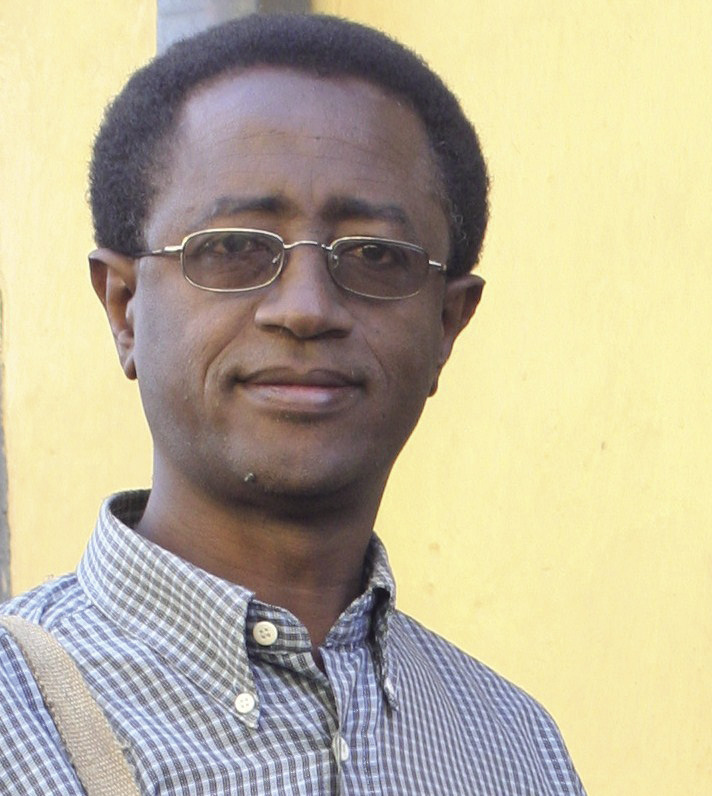 |
|
Mohammed Umer, PAGES SSC member 2006-20011 |
The untimely death of Dr Mohammed Umer Mohammed, during fieldwork in the Afar on 27 November 2011, is a grievous loss to his numerous colleagues and friends in the international community of environmental geoscientists. Mohammed was Associate Professor at the Department of Earth Sciences, Addis Ababa University, for 19 years, where he initiated and led the Paleo-environment and Paleoanthropology Program. He served as a member of the PAGES Scientific Steering Committee, as co-leader of the PAGES Africa 2k Working Group, and of PAGES Science Focus 4 (Past Human-Climate-Ecosystem Interactions). He was a dedicated, inspiring and internationally recognized researcher, a truly dedicated mentor and educator, an ambassador for African science and for PAGES, and a much-valued friend to his students and colleagues.
Mohammed was born on 22 June 1959 in Robe, a small town in the Arsi Mountains, east of Ethiopia’s Rift Valley. He graduated from Addis Ababa University with a BSc degree in Geology in 1981, and taught at Asmara University, Eritrea, for five years, before beginning research at the University of Aix-Marseille III. His PhD, on the vegetation history of the eastern Ethiopian highlands, was completed in 1992, despite the difficulties of undertaking fieldwork during a period of political transition. His subsequent research focused largely on the environmental history of Ethiopia, where he made significant contributions to knowledge of that country’s place in the environmental, cultural and human evolutionary history of Africa. Mohammed took a full part in academic administration, as Associate Dean of the Faculty of Science of Addis Ababa University from 2005 to 2007, and was recently elected a member of the University Council.
Mohammed was a founding member of the East African Quaternary Research Association, and was elected its President in February 2011. He was a member of the executive committee of the International Association of Geomorphologists, and of the steering committee of the Hominid Sites and Paleolakes Drilling Project, supported by the International Continental Scientific Drilling Program. He was a key partner in the current Ethiopian Lakes Paleoenvironmental Reconstruction Project, led from Cologne University. These, and many other international scientific projects in Ethiopia, owe Mohammed a debt of gratitude: he was an essential and indefatigable colleague, making use of his wide-ranging network of friends to smooth the path of fieldwork and conferences, working with Ethiopian, French, American, German and British partners with tireless energy, great good-humor, and boundless enthusiasm.
Personally, I owe much to Mohammed for 18 years of fruitful collaboration and close friendship, during which we shared many memorable times – coring Rift valley lakes, surveying Lake Tana, exploring Mechara caves, and fieldwork on horseback in the mountains of south-western Ethiopia. Without his skills and enterprise, the work would have been almost impossible, and certainly far less enjoyable. He was a marvelous raconteur, with an inimitable style, and a vast store of amusing stories. Only a week before he died, Mohammed clearly enjoyed hosting a lunch party at his home for Ethiopian and international friends. That was just after fieldwork at the Dendi lakes, where he told me that he had now achieved two of his three “dream lakes”, the others being Garba Guracha in the Bale Mountains, for which he published the vegetation history, and the sacred lake on Mt Ziqwala, which he held realistic hopes of investigating.
Hard as it is for us, his friends and colleagues, to know that we will not share more adventures with him, it must be so much harder for Hawsa, his wife, and his two young children to have lost such an inspiring husband and father. His legacy will be for us, his friends, colleagues and students, to continue the research that he so much valued, and to further the training of those who would follow in his path.
Publications
PAGES Magazine articles
2012
PAGES news
Reprint of PAGES e-news, vol. 2011, no. 3 from 5 December 2011
Michael N. Evans1, H. Goosse2, T. Kiefer3, V. Masson-Delmotte4, H.V. McGregor5 and D.W. Oppo6
Following a suggestion from the CLIVAR Scientific Steering Committee (SSC) and a meeting of the PAGES 2k network leadership in Bern, July 2011, the PAGES SSC endorsed the formation of a ninth 2k group focusing on the global oceans: Ocean2k. Motivating this project is an interest in placing observed historical marine conditions into the context of climatic variation over the past 2,000 years (Box 1). We plan to generate two outputs in time for consideration in the IPCC's Working Group I fifth assessment report, and contributing to the PAGES2K synthesis planned for 2014.
The first goal is a metadatabase (Box 2) of Ocean2k-relevant proxy records and model output from publicly-accessible and citable sources, to be completed in January 2012. The metadatabase will comprise paleodata spanning the past 2000 years, as well as climate simulations from the fifth Coupled Model Intercomparison Project (CMIP5) and the third Paleoclimate Modeling Intercomparison Project (PMIP3). We hope that we can detect in the corresponding data and simulations the ocean imprint of large-scale variations in processes such as the Atlantic meridional overturning circulation, annular mode activity, monsoon circulations, and El Niño-Southern Oscillation (ENSO).
The second goal is a synthesis paper, based on the metadatabase, addressing the questions in Box 1, and submitted no later than July 2012. We will review the principal interpretable features in the data and simulations, discuss likely underlying mechanisms, identify leading uncertainties, and highlight areas for future research.
Given the short timeline, Ocean2k is currently not planning project meetings. Instead, we are dividing up the work and using the internet for regular communications. We need your help to achieve the group’s ambitious goals (Box 3).
Further information on project goals is regularly updated at the Ocean2k webpages: http://pastglobalchanges.org/science/wg/2k-network/former-2k-activities/regional-2k-groups/ocean2k/intro
We look forward to working with you.
Box 1: Motivating questions
• What are the principal patterns of variation in ocean properties observed in both paleodata and paleomodeling simulations forced with realistic external forcings?
• What are the most likely underlying mechanisms?
Box 2: Ocean2k matadatabase components and criteria
• Paleoproxy database of marine origin: from the public NOAA/WDC-A (http://www.ncdc.noaa.gov/paleo) and
PANGAEA (http://pangaea.de) data portals
- Variable: local interpretation of the measured proxy data
- Time interval: any portion of the past 2000 years
- Minimum time resolution: decadal to centennial
- Minimum chronology resolution: 1 date per 50-500 years, as applicable
- Uncertainty: internal and/or external reproducibility; interpretation, or bulk uncertainty
- Reference: a citation in the peer-reviewed literature is available
- Data link: A URL to the data source in a publicly accessible data repository
• Climate model output database: from the public CMIP5 (http://cmip-pcmdi.llnl.gov/cmip5/data_portal.html?submenuheader=3) and PMIP3 (http://pmip3.lsce.ipsl.fr) data portals
- Variable, time interval, uncertainty, reference
- Data link: A URL to the model output in a publicly-accessible data repository
Box 3: Call for collaboration
• Have you developed data or modeling results that are not yet archived in a publicly-accessible archive? Please consider contributing it to an appropriate data portal (Box 2). We can then include your work in the paleometadatabase.
• Would you like to collaborate on the synthesis paper during the first half of 2012?
Please contact Mike Evans (mnevans geol.umd.edu). The Ocean2k team is especially looking for a few highly motivated early-career scientists with the time and energy to lead the synthesis paper.
geol.umd.edu). The Ocean2k team is especially looking for a few highly motivated early-career scientists with the time and energy to lead the synthesis paper.
affiliations
1Department of Geology and Earth System Science Interdisciplinary Center, University of Maryland, College Park, USA; mnevans geol.umd.edu
geol.umd.edu
2TECLIM/ELIC, Université catholique de Louvain, Belgique
3PAGES International Project Office, Bern, Switzerland
4LSCE (IPSL/CEA-CNRS-UVSQ), Gif-sur-Yvette, France
5School of Earth and Environmental Sciences, University of Wollongong, Australia
6Woods Hole Oceanographic Institution, Woods Hole, USA
